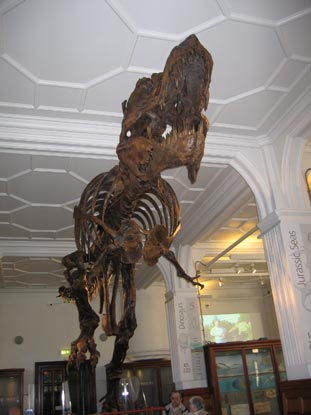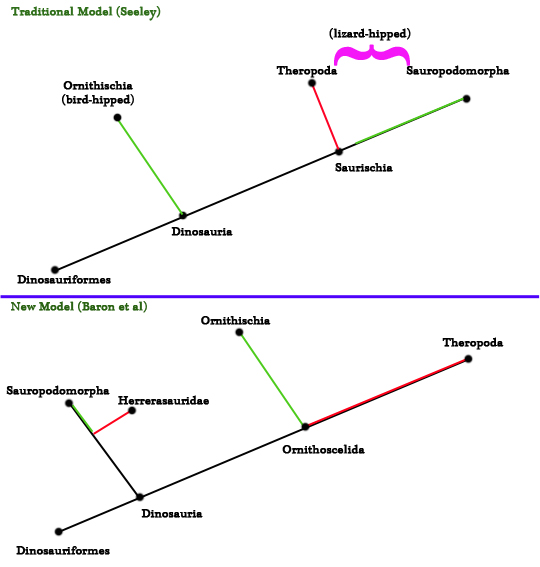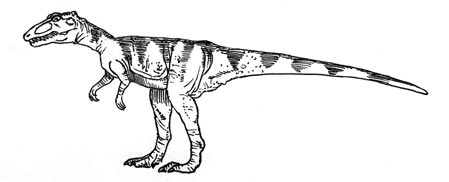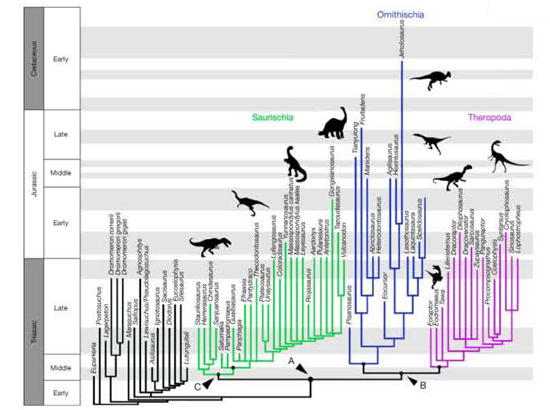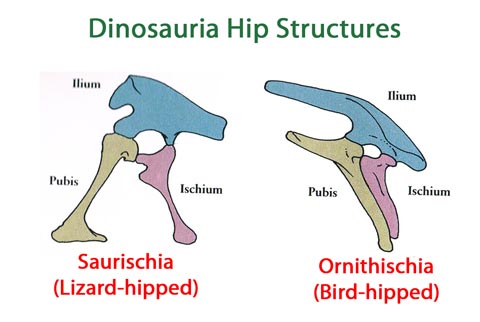Root and Branch Reform for the Dinosaur Family Tree
Dinosaur Family Tree Given a Hefty Shake
So, the scientific paper is out, published in the journal Nature and with the snappy title “A New Hypothesis of Dinosaur Relationships and Early Dinosaur Evolution”. Just about everything that we thought we knew about when, where and how the dinosaurs evolved has been turned on its head. In addition, the dinosaur family tree has been re-drawn, all the text books written about these iconic prehistoric animals published since 1887, basically got it wrong! It’s a big story, it dwarfs Argentinosaurus! So, let’s take a step back and examine what exactly does this new paper mean.
New Study Suggests Tyrannosaurus rex was put on the Wrong Branch of the Dinosaur Family Tree
Picture credit: Everything Dinosaur
Summarising the Key Findings
We have tried to summarise the key findings as:
- The clades that make up the Order Dinosauria, need to be rearranged.
- Theropod dinosaurs which are closely related to modern birds, previously classified as saurischian dinosaurs (lizard-hipped), need to be grouped with the bird-hipped forms in a new clade proposed as the Ornithoscelida.
- Bird-hipped dinosaurs (Ornithischia) clade now directly associated with the evolution of birds.
- Lizard-hipped Sauropodomorpha, the clade that includes Diplodocus, Plateosaurus and Argentinosaurus et al would now fall outside the Order Dinosauria.
- The definition of what a dinosaur is (Dinosauria) would have to be changed to allow the Sauropodomorpha back in.
- The first dinosaurs may not have evolved in the Southern Hemisphere (South America or southern Africa – Gondwana), but they may have evolved further north on the landmass called Laurasia.
- Under this new redrawing of the dinosaur family tree, some of the dinosauriforms (ancestors of the Dinosauria), such as Saltopus (fossils from Scotland) and the controversial Agnosphitys (fossils from Avon), provide evidence to support the idea that some of the very first dinosaurs may have evolved in the area we now know as the UK.
- The first types of dinosaur may have been omnivores and not carnivores as generally accepted.
- With this re-definition of dinosaur evolution, the first dinosaurs evolved some 247 million years ago, pushing the origins of the Dinosauria back some 15 million years.
The Traditional Dinosaur Family Tree Compared to the New Model
Picture credit: Everything Dinosaur (from Baron et al 2017)
The Dinosaur Family Tree
The picture above shows (top) the traditional view of the dinosaur family tree as proposed by Henry Govier Seeley in a paper entitled “On the Classification of the Fossil Animals Commonly Named Dinosauria” published in the Proceedings of the Royal Society (London) back in 1887. This has been the accepted, conventional interpretation for the last 130 years or so.
The new model is depicted (bottom), this interpretation reflects in part, the dinosaur family proposed by Thomas Huxley in a paper published in 1870, entitled “On the Classification of the Dinosauria with Observations on the Dinosauria of the Trias” in the quarterly journal of the Geological Society.
Back in 1870, Huxley looked at compsognathids, iguanodontids, megalosaurs and the primitive armoured dinosaur Scelidosaurus and found enough common characteristics amongst these different types of dinosaur to unite them into a single clade, which he called the Ornithoscelida (orn-nith-oh-skel-lie-dah). The research team, writing in the academic journal “Nature” had many thousands more fossils to study than either Huxley or Seeley, they conclude that Huxley’s interpretation has more validity than the conventional view that gives precedence to Seeley’s interpretation. Baron et al suggest that the term Ornithoscelida be resurrected to apply to ornithischians and the Theropoda.
Hypercarnivory (Meat-eating) Evolved Twice
Everything Dinosaur’s comparison of the two family trees shows something else. The green lines lead to those groups of dinosaurs that were predominantly herbivorous, whilst the red lines lead to dinosaur types that comprise mainly carnivores. In the new model, the Sauropodomorpha, dinosaurs like Diplodocus and their kind are placed outside the new definition of the Dinosauria. The herrerasaurids (Herrerasauridae), with their confusing array of dinosaur and non-dinosaur traits, are also placed outside the new strict definition of what dinosaurs are. Dinosaurs like Herrerasaurus are not classified as theropods in this new model, which means that meat-eating in dinosaurs evolved twice, once in the herrerasaurids and once in the Theropoda.
Herrerasaurus Gets a New Status within the Revised Dinosaur Family Tree
Picture credit: Everything Dinosaur
Science Itself Evolves
At Everything Dinosaur, we define science as “the search for truth”. The authors of this new paper, graduate student Matthew Baron, Dr David Norman (Cambridge University) and Professor Paul Barrett (London Natural History Museum), reviewed a total of seventy-four different types of dinosaur and looked at their common traits and characteristics. They started with a blank sheet of paper, bravely set aside conventional thinking and tried to find the best fit for the scientific evidence.
Explaining the researcher’s approach, a spokesperson from Everything Dinosaur commented:
“When you put together a jig-saw puzzle, you might refer to the picture on the front of the box to guide you. What these scientists did was to look at the jigsaw pieces, ignoring the picture on the front of the box and they worked out which pieces fitted together well and which pieces didn’t. They took a fresh look at the evidence and came up with a new way of mapping out the dinosaur family tree. Based on the evidence, they found a better way to put the jigsaw pieces together.”
The researchers carefully studied thousands of fossil bones and mapped 457 anatomical characteristics across the 74 different types of dinosaur. This meticulous study led them to re-draw the cladogram that represents the dinosaur family tree.
A Phylogenetic Relationship of Early Dinosaurs Plotted Against Geological Time
The diagram above show the newly proposed phylogenetic relationship plotted against geological time for the early dinosaurs and their close relatives (Dinosauriformes).
A = the least inclusive grouping (clade) that includes the House Sparrow, Triceratops and Diplodocus.
B = the least inclusive grouping (clade) that includes the House Sparrow and Triceratops (the Ornithoscelida).
C = the most inclusive clade that contains Diplodocus but not Triceratops – (the new definition of the Saurischia).
Not “Throwing the Baby Out with the Bathwater”
This is a fascinating and intriguing insight into the phylogenetic relationships of the Dinosauria and their closest relatives. However, numerous studies have been conducted in the past and Henry Govier Seeley’s analysis has held sway. Some of the conclusions drawn are likely to be challenged by other palaeontologists and the debate as to the cladistic relationships and the implications for how, when and where the dinosaurs evolved is going to continue.
Take for example, the idea that the dinosaurs may have evolved further north than previously thought. The fossils from Scotland and the west country of England (Avon) are highly fragmentary and far from complete. Indeed, much of the Triassic material ascribed to early types of dinosaur or their near relatives, the Silesauridae, is very piecemeal. Many more fossils need to be found before a clearer picture as to the origins of the Dinosauria can be established.
Footnote
Back in April 27th 2015, Everything Dinosaur published a blog article all about the discovery of a bizarre new theropod dinosaur named Chilesaurus (C. diegosuarezi). Although it was classified as a member of the lizard-hipped Theropoda, a group that were predominately meat-eaters, this Late Jurassic, South American dinosaur took a very different evolutionary path – it seems to have become a herbivore. Chilesaurus, shows anatomical characteristics quite unlike any other theropod dinosaur. Not least, the pubis bone is projecting backwards, which is similar in orientation to the layout of the pelvic girdles of ornithischian (bird-hipped) dinosaurs.
Our article about this very curious dinosaur required us to use an annotated diagram that showed the differences in the hip bones of the Saurischia (lizard-hipped) and the Ornithischia (bird-hipped) dinosaurs. We are honoured that this same illustration was used by the BBC in the coverage of this new scientific paper.
Classifying the Dinosauria by Their Hip Bones
Picture credit: Everything Dinosaur
The scientific paper: “A New Hypothesis of Dinosaur Relationships and Early Dinosaur Evolution” M. Baron et al published in the journal Nature.
Visit the Everything Dinosaur website: Everything Dinosaur.


